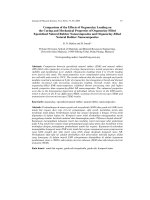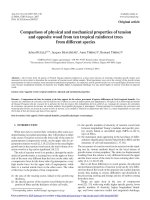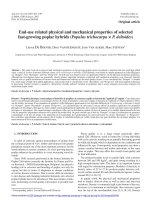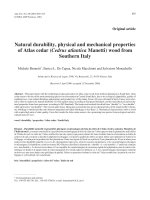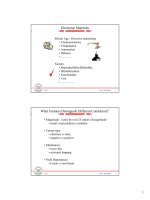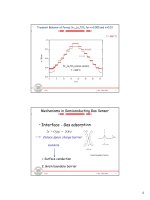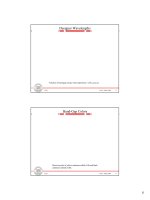Unique glass formation and mechanical properties of zr cu based alloys
Bạn đang xem bản rút gọn của tài liệu. Xem và tải ngay bản đầy đủ của tài liệu tại đây (4.16 MB, 153 trang )
UNIQUEGLASSFORMATIONANDMECHANICAL
PROPERTIESOFZR‐CU‐BASEDALLOYS
WUWENFEI
(M.Eng,TsingHuaUniv.)
A THESIS SUBMITTED
FOR THE DEGREE OF DOCTOR OF PHILOSOPHY
DEPARTMENT OF MATERIALS SCIENCE &
ENGINEERING
NATIONAL UNIVERSITY OF SINGAPORE
2008
i
Acknowledgments
Firstofall,Iwouldliketothankmysupervisor,Associate ProfessorYiLi. I
wouldnotbeabletocometoSingaporeifProfessorLihadnotofferedmethe
opportunitytofurthermystudyinNUSinthesummerof2004.Heisatruly
excellentteacher,dedicated
scientist,andsupportiveperson.Ihavereceived
invaluable technical advice and constant encouragement from him, all of
which have been essential to the completion of my Ph.D. project. His open
and scholarly mind has made it possible for me to enjoy more or less
independentresearch.Withthepast4years
ofworkingwithhim,Ihavebeen
enlightenedtobemoreanalytic,logicandrational.Ifeeldeeplyindebtedto
himandwouldliketoexpressmysinceregratitudetohim.
IamgratefultoProfessorChristA.SchuhinMassachusettsInstituteof
Technology, United States, for his precious discussion
during the
collaborative work presented in Chapter 3 and his valuable suggestions for
the work presented in Chapter 5. His erudition, insights, and professional
attitude have left me with a great impression. I would also like to thank
Professor YongWei Zhang, and his student Dr. ChunYu Zhang in NUS, for
ii
theirfruitfuldiscussion,suggestionsandalltheeffortduringthecollaborative
workpresentedinChapter4.IamgratefultoProfessorKaiYang ZenginNUS,
forvaluablediscussionsonmanyissuesofthemechanicaltesting.
I am indebted to the dedicated staff members in the Department of
MaterialsScience&Engineering
fortheirconstanthelpinvariousways,and
theNationalUniversityofSingaporeforfinancialsupport.
Tothe group membersof the Non‐EquilibriumMaterialsLab, former
seniorsDr.DongMa,Dr.ShirleyMeng,Dr.YongZhang,Dr.HuiZiKong,Dr.
HaoTan,Dr.IreneLee,DongWang,Dr.
JieZhang,Dr.XiaoLingFu,CuiYang
Wang,Dr.XiaoQiangZhang,KaiYangLim,andthepresentcolleguesDr.Hai
Yang,GraceLim,ZhengHan, XiangLi,Qiang Guo,andDr. ZhiYuWang,I
extendmyverysincerethanks.Theexperienceofworkingtogetherwiththese
talentedguyswasawonderfulmemory
inmylife.
It is my great pleasure to acknowledge my friends in Singapore:
Professor JunMin Xue, Jian He, Hua Ma, ZhongQiao Hu, HongYu Liu,
YouSheng Zhang, Jian Zhang, Thongmee Sirikanjana and GuangXia Hu. I
haveenjoyedthegreattimethatwehavespenttogether.
Last but not least, I
am deeply indebted to my family (my parents,
youngersisterandgirlfriend)fortheirgreatloveandunderstanding.Without
theirconstantsupportIwouldnothavehadthestrengthtoreachthisstage.
August2008inSingapore, WenFeiWU
iii
TableofContents
Acknowledgments i
TableofContents iii
Summary v
ListofTables viii
ListofFigures ix
ListofPublication xv
1Introduction 1
1.1 Introductiontobulkmetallicglasses(BMGs) 2
1.2 FormationofBMGs 6
1.2.1 Thermodynamicsperspective 7
1.2.2 Kineticsperspective 8
1.2.3 Frequentlyusedindicatorsandrules 10
1.3 MechanicalbehaviorofBMGs 17
1.3.1 Inhomogeneousdeformation 17
1.3.2 Deformationmechanisms 24
1.3.3 BMGmatrixcomposites 27
1.4 Objectiveandoutlineofthisthesis 31
2
Bulk“intermetallicglass”byrapidquenching 33
2.1 Introduction 33
2.2 Experimentalprocedure 36
2.3 ResultsandDiscussion 37
2.3.1 Glassformation 37
2.3.2 Mechanicalproperties 45
2.4 Conclusions 52
iv
3StatisticaleffectonstrengthofBMGs54
3.1 Introduction 54
3.2 Experimentalprocedure 58
3.3 ResultsandDiscussion 61
3.3.1 Weibullstatisticsofstrength 61
3.3.2 CorrelationsbetweenWeibullmodulus,GFAandmalleability70
3.4 Conclusions 74
4
StressgradientenhancedplasticityinamonolithicBMG 75
4.1 Introduction 75
4.2 Experimentalprocedure 77
4.3 Results 79
4.4 Discussion 83
4.4.1 FiniteElementAnalysis(FEA) 83
4.4.2 Stressgradientinearlystage 88
4.4.3 Shearbandinitiationandproliferation 91
4.4.4 CurvedShearbandpathandinteractionofshearbands 97
4.4.5 Applicationofstressgradient
strategyinabrittleBMG 98
4.4.6 Geometry‐sensitiveplasticityofBMGs 101
4.5 Conclusions 102
5
Size‐dependentʺmalleable‐to‐brittleʺtransitioninaBMG 104
5.1 Introduction 104
5.2 Experimentalprocedure 106
5.3 ResultsandDiscussion 108
5.3.1 “Malleable‐to‐brittle”transition 108
5.3.2 Sizedependenceofstrength 111
5.3.3 Fractography 115
5.4 Conclusions 119
6
Concludingremarks121
6.1 Summaryofresults 121
6.2 Futurework 124
Bibliography 125
v
Summary
The research area of amorphous metals was replenished recently with the
discoveryofbulk‐sizedmetallicglasses(BMGs)invarioussystemsinthepast
decades. In this research field, the formation and mechanical behavior of
BMGs are the two major sub‐areas, which were the focuses of the present
work.
ThefirstsignificantfindingofthisworkisthediscoveryofbulkZr‐Cu
“intermetallicglass”,whichisanewgroupofglassformedinthevicinityof
intermetallics of the phase diagram by rapid quenching. This finding is
remarkablebecauseintheconventionalbelief,metallicglassiseitherformed
near deep‐eutectics through liquid quenching or near the centre of ph ase
diagram by solid‐state reaction. This discovery is believed to open an
otherwiseoverlookedarenaforfindinganewhostofmetallicglasses.
Upon mechanical loading, metallic glasses generally fail
catastrophicallybyonedominantshearbandwithvery
limitedplasticstrain,
similartothoseoftypicalbrittlematerials.Inviewofthisbrittlefracture,to
addresstheflawsensitivityissueinBMGsthusbecomesessential.Thesecond
vi
contributionofthisworkistoinvestigatesystematicallythestrengthvariation
ofBMGsbyapplyingWeibullstatistics.Theresultsshowedsurprisinglyhigh
Weibull moduli approaching the range for crystalline metals, despite their
brittleness. These high Weibull moduli of the BMGs indicate that these
materials are highlyuniform instrength,and thus
much more mechanically
reliable than expected in light of their flaw sensitivity. Such reliability is
encouragingforthepotentialuseofBMGsasanengineeringmaterial.
Thethirdpartofthisthesisiscloselyfollowingthepreviouspart.The
high strength uniformity indicates that there is a small allowed variation
range in stress for the shear band initiation. Therefore, if a large stress
gradient could be introduced inside the sample, the propagation of shear
bandcouldberestricted,newshearbandsmightbeencouragedtobeformed,
andthustheplasticitycouldbeenhanced.Wethusproposedanewconcept‐
“stressgradientenhancedplasticity”‐toalleviatetheconcernofcatastrophic
failure of monolithic BMG using non‐orthogonal samples for illustration. It
not only suggests that, the deformation ofBMGcould be much sensitive to
thespecimengeometry;butmoreimportantly,itoffersanewwaytotoughen
themonolithic“brittle”glassy
alloyswithpracticalsignificance.
The fourth contribution of this thesis is to identify the existence of a
ʺmalleable‐to‐brittleʺtransitioninBMGoccurredatacriticalsamplesizeunder
both as‐cast and annealed states. Contrary to the traditional view that the
sample size dependence of malleability is
attributed to free volume
vii
differences, we proposed that this transition should be related to the
geometrical size effect, which is later proven by the observation of such a
transition even in the annealed BMG samples. In addition, a sample size
dependenceofstrengthaccompaniedwiththistransitionwasalsoidentified.
Itissuggestedthat,to
determinethecriticalsizesforthe“malleable‐to‐brittle”
transition in BMGs is extremely important and should provide valuable
guidancefortheircomponentdesign.
viii
ListofTables
Table 1. 1 TypicalBMG systemswiththeircritical sizesandyears in
whichtheyweredeveloped. 4
Table1.2PossibleapplicationfieldsforBMGs 5
Table2.1MechanicalpropertiesofZr
48.5Cu51.5,Zr51Cu49,Zr49.5Cu50.5,and
Zr
49Cu51 as‐cast alloys, with various volume fraction of ZrCu
martensite in the amorphous matrix, under co mpression at room
temperature 47
Table 2. 2 Mechanical properties of the samples 1‐5, which were cut
fromthedifferentpartofonesingleZr
48.5Cu51.5as‐cast2mmrod,with
variousvolumefractionsofZrCumartensitephaseintheamorphous
matrix 51
Table 3. 1 Summary of the measured mechanical properties of
orthogonal Zr
51Cu49, Zr48Cu45Al7 and (Zr48Cu45Al7)98Y2 BMG specimens
undercompressiontesting. 64
Table3.2SummaryoftheWeibullmoduliforvariousmaterials 67
Table4.1CriticalmaterialparametersusedintheFEA 86
Table5.1ThermalpropertiesoftherepresentativeZr
48Cu45Al7as‐cast
and annealed rods obtained from their DSC measurements.∆H
r
denotestheexothermicheatforstructuralrelaxation 107
ix
ListofFigures
Figure 1. 1Schematicdiagramofglassformationbyrapidquenching
ofaliquidwithoutcrystallization.Line1correspondstocrystallization
at low cooling rate, and Line 2 corresponds to vitrification at high
coolingrate 3
Figure1.2DifferenceinGibbsfreeenergybetweentheliquidandthe
crystallinestate
forglass‐formingliquids.Thecriticalcoolingratesfor
the alloys are indicated in the plot as K/s values beneath the
compositionlabels,reproducedfrom[40] 8
Figure 1. 3Angellplotcomparingtheviscositiesofdifferenttypesof
glass‐formingliquids,reproducedfrom[43] 9
Figure 1. 4 Variation of logarithm
of homogeneous nucleation rate I
withreducedglasstransitiontemperatureT
r.Tr=T/Tm,Trg=Tg/Tm.T,Tg,
T
m are, respectively, the actual absolute temperature, the glass
transition temperature, and the melting temperature of alloys,
reproducedfrom[55] 12
Figure 1. 5 Schematic diagram shows T
rg reaches maximum value
around the eutectic point for a typical binary eutectic alloy phase
diagram 13
Figure1.6RelationshipbetweencriticalcoolingrateR
c,criticalsizetmax,
andtheinterval of supercooledliquid region
△
Txfor variousBMGs,
reproducedfrom[7] 14
Figure1.7Phase‐formationmapsincludingtheglass‐andcomposite‐
formingregionsfor thetwokinds of eutecticsystem. (a)In a regular
eutecticsystem,thebestglass‐formingrangeincludestheeutectic(Eu)
composition.(b)Inanirregulareutecticsystem,theeasy
glass‐forming
x
rangewouldbeoutsidetheeutecticcomposition.
T
isthecoolingrate
andCisthecomposition,reproducedfrom[59] 16
Figure 1. 8 Schematic deformation map for an amorphous metal
illustrating the temperature and stress regions for homogeneous and
inhomogeneousplasticflow,reproducedfrom[66] 18
Figure1.9Schematicillustrationoftypicalstrengthsandelasticlimits
for various
materials. Metallic glasses are unique with high strength
andhighelasticlimit. 19
Figure 1. 10 SEM micrographs illustrating the “slip steps” or surface
offsetsassociatedwithshearbandsindeformedmetallicglasses.(a)a
stripof Zr
57Nb5Al10Cu15.4Ni12.6BMG underbendingtest,adaptedfrom
[74], and (b) a Zr
52.5Cu17.9Ni14.6Al10Ti5 BMG under compression test,
adaptedfrom[75] 20
Figure 1. 11Serratedflowofmetallicglasses,throughrepeatedshear
band operation in confined loading. In (a), a Pd
77.5Cu6Si16.5 specimen
with low aspect ratio under compression, adapted from [84], and (b)
Pd
40Cu30Ni10P20glassunder an load‐control instrumented indentation,
adaptedfrom[87] 22
Figure1.12Effectofthedimensionlessratioofshearandbulkmoduli
(μ/B) on the toughness of various glasses, expressed in terms of the
fractureenergyG
c,reproducedfrom[90]. 24
Figure1.13Two‐dimensionalschematicsoftheatomisticdeformation
mechanismsproposedforamorphousmetals(a)sheartransformation
zonemodel[67](b)freevolumemodel[66],reproducedfrom[76]. 25
Figure 1. 14 (a) Microstructures of Nb reinforced
Zr
41.2Ti13.8Cu12.5Ni10Be22.5BMGmatrixcompositeand(b)itscompressive
stress‐straincurveforcylindricalspecimen,adaptedfrom[122] 29
Figure 1. 15 Backscattering SEM image (a) of cross‐section of
La
74Al14(Cu,Ni)12BMGmatrixcompositeswith50%involumefraction
of crystalline phase and representative tensile stress‐strain curves of
monolithic amorphous alloy and composite samples, adapted from
[99] 30
xi
Figure1.16(a)SEMmicrographofneckinginZr39.6Ti33.9Nb7.6Cu6.4Be12.5
BMG matrix composites, and (b) Brittle fracture representative of all
monolithicBMGs,adaptedfrom[123] 30
Figure 2. 1 Two conventional glass forming regions. (a) A schematic
phase diagram of a binary alloy system consisted of two eutectics
separated by an intermetallic phase. Two distinct glass forming
regions (shaded area) based on Turnbull’s kinetics Trg criterion for
quenched glass (b) and thermodynamics consideration for solid‐state
reactedglass(c). 34
Figure 2. 2 The representative XRD spectrums of Zr
xCu100‐x (x=45‐56)
as‐cast 2 mm alloys. Five regions with distinct microstructures are
observed. 38
Figure 2. 3 TherepresentativeSEMmicrographsofZr
xCu100‐x(x=45‐56)
as‐cast2mmalloys. 40
Figure2.4TherepresentativeDSCcurvesofZr
xCu100‐x(xfrom48.5to
51)meltspunribbonsandas‐castbulksamples. 40
Figure 2. 5 Hypothetic free energy curves and forming region of
“intermetallic glass” under quenching. The “intermetallic glass”
formingregion(redsolidline)withtwooptimum“intermetallicglass”
formers(purplesolidcircle)werelocatedclosetobut
separatedbythe
equiatomiccompositionin thecorresponding portionofZr‐Cuphase
diagram.Thetwo“eutecticglasses”atZr
44Cu56[133]andZr55Cu45[134]
weremarkedinblackopencircleforcomparison. 42
Figure2.6Theengineeringcompressivestress‐straincurvesofZr‐Cu
amorphous matrix composites with varied volume fraction of ZrCu
martensite. A‐ Zr
48.5Cu51.5 and B‐ Zr51Cu49 alloy with fully amorphous
structure; C‐ Zr49.5Cu50.5 alloy with 40% of ZrCu martensite, and D‐
Zr
49Cu51alloywith77%ofZrCumartensiteintheamorphousmatrix. 46
Figure 2. 7 Scanned micrograph of longitudinal cross section of a
whole2mmas‐castZr
48.5Cu51.5rod.Themicrostructuralinhomogeneity
in the longitudinal direction was observed. Sample 1‐5 are
representativesofvariousmicrostructures 49
Figure 2. 8 The compressive stress‐strain curves of the samples 1‐5,
whichwerecutfromthedifferentpartofonesingleZr
48.5Cu51.5as‐cast2
mmrod. 50
xii
Figure 3. 1 XRD patterns of representative Zr
51Cu49, Zr48Cu45Al7 and
(Zr
48Cu45Al7)98Y2as‐castrods.TheinsetshowstheircorrespondingDSC
curves, with the glass transition (T
g) and onset crystallization
temperature(T
x). 60
Figure3.2Compressivestress–straincurvesof18orthogonalZr
51Cu49
BMGspecimens,offsetfromoneanotheronthestrainaxisforclarity
ofpresentation 62
Figure 3. 3 Compressive stress–strain curves of 24 orthogonal
Zr
48Cu45Al7BMGspecimens,offsetfromoneanotheronthestrainaxis
forclarityofpresentation 63
Figure 3. 4 Compressive stress–strain curves of 47 orthogonal
(Zr
48Cu45Al7)98Y2BMGspecimens,againdisplacedonthestrainaxisfor
clarity. 63
Figure3.5(a)WeibullplotsofZr‐Cu‐basedBMGsundercompression.
TheirWeibullmoduliare:(A)112forZr
51Cu49;(B)73.4forZr48Cu45Al7;
and (C) 25.5 for (Zr
48Cu45Al7)98Y2. (b) The corresponding Weibull
strengthdistributionfunctiondescribesthefractionofthesamplesthat
failatany given compressive stress;notethelefthandskew of these
distributions 66
Figure3.6TheXRDpatternsofthreeas‐castZr‐Cu‐basedalloyswith
differentsizes.Thecriticalsizeswere
foundtobe2mm,5mmand8
mmforZr
51Cu49,Zr48Cu45Al7,and(Zr48Cu45Al7)Y2,respectively. 72
Figure 3. 7The correlation between GFA (critical size), the plastic
strainpriortofailure,andWeibullmodulusforthethreeZr‐Cu‐based
BMGs.Thedataforoxideglassisalsoplottedforcomparison 73
Figure 4. 1 BMG samples with three designed geometries (a)
orthogonal,(b)monoclinic,
and(c)transitional. 79
Figure4.2Therepresentativecompressiveload‐displacementcurveof
Zr
48Cu45Al7 BMG with the orthogonal geometry. The inset shows the
fracturedspecimenafterverylimitedplasticdeformation(1.3%). 80
Figure4.3Therepresentativecompressiveload‐displacementcurveof
Zr
48Cu45Al7BMGwiththemonoclinicgeometry.Theinsetshowsthe
specimenafterdeformation.Theenlargedareashowsslightserrations
inthestressstraincurve 81
xiii
Figure4.4Therepresentativecompressiveload‐displacementcurveof
Zr
48Cu45Al7BMGsamplewiththetransitionalgeometry.Theenlarged
areashowsintenseserrationsinthestressstraincurve 82
Figure 4. 5 The morphology of fractured Zr48Cu45Al7 BMG specimen
withthetransitionalgeometry 83
Figure4.6Compressiveload‐displacementcurveswiththreedesigned
geometriessimulatedbyFEA. 87
Figure4.7TheMisesstressdistributionofsampleundercompression
with different geometries at a total cross‐head displacement of 0.03
mm. 90
Figure 4. 8 The quantitative
stress gradients along the sample width
directionattheposition0.5mmawayfromthebottomsurface. 90
Figure4.9showstheshearbandsevolutionintheorthogonalsample
predictedbytheFEA 91
Figure4.10showstheshearbandsevolutioninthemonoclinicsample
predictedbytheFEA 92
Figure4.11showstheshearbandsevolutioninthetransitionalsample
predictedbytheFEA 94
Figure4.12Thetypicallybrittle(Zr
48Cu45Al7)98Y2BMGwithapyramid
geometry shows good deformability after yielding. The load‐
displacementprofilesoftheorthogonalBMGsamplewithaspectratio
of0.75and2arealsoplottedforcomparison. 99
Figure4.13Themorphologyofpyramid(Zr
48Cu45Al7)98Y2BMGsample
before (a) and after (b) compression. Multiple shear bands with
semicircular trajectories were observed in the top of the deformed
pyramidsamplesurface(b),asshownathighmagnificationin(c).The
FEAresultssuggestthatthestressgradient(d)presentinthepyramid
sample accounts for the
enhanced plasticity in this otherwise brittle
glass 100
Figure5.1PartofDSCtracesofrepresentativeZr
48Cu45Al7rodsunder
as‐cast and annealed states. The XRD patterns shown in the inset
verifiedthefullyamorphousstructureofsamplesstudied. 107
xiv
Figure5.2R epresentativestress‐straincurvesofZr48Cu45Al7(a)as‐cast
and(b)annealedsampleswithdifferentsizesundercompression.An
evident“malleable‐to‐brittle”transitionwasobservedinbothstates 109
Figure5.3Thesamplesizedependenceof(a)strengthand(b) average
plasticstraininZr
48Cu45Al7BMG 114
Figure 5. 4 (a) Fractography observation of 1.5 mm sized Zr
48Cu45Al7
as‐cast BMG. The black arrow in (a) shows the direction of shearing
deformation.Magnifiedviews oftheregionA, andBindicated in(a)
are shown in (b), and (c), respectively. The side view of the sample
shownin(d)suggestsapurelyshearingmodeoffracture. 116
Figure 5.
5 (a) Fractography observation of 4 mm sized as‐cast
Zr
48Cu45Al7BMG.Theblackarrowin(a)showsthesheardirection.The
typicalmorphologiesinregionAandBof(a)areshownin(b)and(c),
respectively. The side view is shown in (d). Local melting was
frequently observed in the fracture surface as circled in (a), the
magnifiedviews
ofcircleIandIIareshownin(e),and(f),respectively 117
xv
ListofPublication
1. W. F. Wu
, Z. Han, and Y. Li. Size‐dependentʺmalleable‐to‐brittleʺ
transition in a bulk metallic glass. Applied Physics Letters, 2008, 93:
061908
2. W.F.Wu
,C.Y.Zhang,Y.W.Zhang,K.Y.ZengandY.Li.Stressgradient
enhanced plasticity in a monolithic bulk metallic glass. Intermetallics,
2008,16:1190
3. W.F.Wu
,Y.Li.Geometry‐sensitiveplasticityofamonolithicbulkmetallic
glass.Mater.Res.Soc.Symp.Proc.,2008,1048:Z05‐06
4. W. F. Wu
, Y. Li and C. A. Schuh. Strength, plasticity and brittleness of
bulkmetallicglassesundercompression:statisticalandgeometriceffects.
PhilosophicalMagazine,2008,88:71
5. W. F. Wu
, and Y. Li. Bulk “intermetallic glass” by rapid quenching.
(Submitted)
6. Z.Han,W. F. Wu
,Y.Li, Y. J. Wei andH. J. Gao. An instabilityindexof
shear band for plasticity in metallic glasses. Acta Materialia, 2009, 57:
1367
7. Z.Han,H.Yang,W.F.Wu
,Y.Li.Invariant critical stress for shear banding in a
bulk metallic glass. AppliedPhysicsLetters,2008,93:231912
1.Introduction
1
Chapter1
Introduction
MetallicGlass (MG) isa metalbasedamorphoussolid.TheresearchonMG
hasrecentlybeenrevisitedowingtothediscoveryofanumberofbulksized
(i.e.≥1mm)MGsamples,whicharecalled “bulkmetallicglasses”(BMGs).
TheBMGsareofgreatinterestbothinscienceandin
engineeringduetotheir
superiorpropertiessuchashighelasticlimit,highstrength,hightoughnessas
wellashighcorrosionresistance[1].Theyareverystablebecauseofthelarge
supercooled liquid region. Their superplastic behavior at elevated
temperature makes them a good candidate for net shaping materials. They
1.Introduction
2
havealsobeenusedasthematerialforfabricatinggolfclubhead,handphone
casing,andpenetrators[2].
Inthefirstchapter,ageneralintroductiontoBMGswillbegiven.The
development, general properties and applications of BMGs will be briefly
reviewed.Afterthis,Iwillfocus ontheformationas
wellas themechanical
behavior of BMGs, which are the major concerns of this thesis, and the
fundamental yet important knowledge such as Turnbull’s kinetic theory on
glassformationandSpaepen’sdeformationmapofamorphousalloyswillbe
reviewed in detail. Theobjectives for the current work will then be
pointed
out.Thefirstchapterwillendwithanoutlineofthethesis.
1.1 Introductiontobulkmetallicglasses(BMGs)
Metallic glasses are metals or metal alloys with no long range atomic order
(LRO).Theyarepreparedbyrapidsolidificationofthealloyingconstituents
from liquid phase. The solidification occurs so rapidly that the atoms are
frozenintheirliquidconfiguration(
Figure1.1)[3].
ThefirstmetallicglassAu
75Si25was reportedbyDuwez[4]in1960.He
made this discovery by chilling metallic liquidsatvery high ratesof 10
5
‐10
6
K/s. Using rapid solidification methods such as splat quenching and melt
1.Introduction
3
spinningwithcharacteristiccoolingratesin therangeof 10
3
‐10
6
K/s,metallic
glasseswerefoundinmany binary andternaryalloysystems[3].However,
foralongtime,thecriticalsizefortheknownmetallicglasseswasinmicron
scale(usually<0.2mm),whichhaslimitedtheiruseasengineeringmaterials.
crystal
T
m
T
g
X
Y
liquid
T
log t
glass
crystal
T
m
T
g
X
Y
liquid
T
log t
glass
Figure1.1Schematicdiagramofglassformationbyrapidquenching
of a liquid without crystallization. Line 1 corresponds to
crystallization at low cooling rate, and Line 2 corresponds to
vitrificationathighcoolingrate.
In1974,Chen[5]synthesizedamorphousrods withdiameter up to 3
mm among several ternary noble metal alloy systems such as Pd‐Cu‐Siand
Pd‐Ni‐P by water quenching with cooling rates of 10
3
K/s or less. If one
arbitrarilydefineslargerthan1mminthesmallestdimensionofthesampleas
“bulk”, these ternary glasses were the first examples of “bulk” metallic
glasses (BMGs) [1]. Till the late 1980s, Inoue and co‐workers successfully
1.Introduction
4
preparedthe“first”BMGwithoutnoblemetalsLa55Al25Ni20[6]bycoppermold
casting, which is the beginning of a new era for BMGs. Subsequently new
BMGshavebeendiscoveredinmanyothersystemssuchasZr,Cu,Fe,Ni,Ti,
Nd,Ca,Y,Ce,andAubasedalloysystems[7‐11].Todate,thelargestcritical
sizeof
theknownBMGsis72mmforthePd40Cu30Ni10P20[12]alloyobtained
byfluxingmethod.
Table1. 1summarizesthetypicalBMGsystemswiththeir
criticalsizesandtheyearsinwhichtheywerefirstreported.
Table1.1TypicalBMGsystemswiththeircriticalsizesandyearsin
whichtheyweredeveloped.
BMGsystem Year Criticalsize(mm) Ref.
Pd‐(Cu,Ni)‐Si
(Pd,Pt)‐Ni‐P
1974 3 [5]
Pd–Ni–P 1982 10 [13]
La‐Al‐Ni 1990 3 [6]
Mg‐Cu‐Y 1991 4 [14]
Zr‐Ti‐Cu‐Ni‐Be 1993 >14 [15]
Zr‐Al‐Ni‐Cu 1993 30 [16]
Ti‐Zr‐Cu‐Ni 1995 4 [17]
Fe‐Al‐Ga‐P‐B‐C 1995 1 [18]
Pd‐Cu‐Ni‐P
1997 72 [12]
Nd‐Al‐(Fe,Co) 1997 15 [19]
Ti‐Ni‐Cu‐Sn 1998 6 [20]
Ni‐Nb‐(Cr,Mo)‐P‐B 1999 1 [21]
Cu‐(Zr,Hf)‐Ti 2001 4 [22]
Fe‐Cr‐Mo‐C‐B‐P 2002 3 [23]
Co‐Fe‐Ta‐B 2003 2 [24]
Ni‐
Ti‐Cu‐Zr‐Al 2004 5 [25]
Cu‐Zr‐Al‐Y 2004 10 [26]
Cu‐Zr 2004 2 [27‐29]
Fe‐Co‐Cr‐Mo‐C‐B‐Y 2005 16 [30]
Ca‐Mg‐Ni 2005 13 [9]
Au‐Ag‐Pd‐Cu‐Si 2005 5 [10]
Mg‐Cu‐Ag‐Gd 2005 25 [31]
1.Introduction
5
Recently,thecriticaldiameterDcforglassformation(i.e.,themaximum
diameterofarodthatcanbecastfullyglassy)hasexceeded1cmforawider
varietyofalloysystemssuchasthosebasedonFe[32],Co[33],Ni[34]orCu
[35], resulting in significantly increased engineering importance for bulk
metallic
glasses(BMGs).
Table 1. 2 summarizes fields of application in which the bulk
amorphous alloys have expected uses. Considering the recent significant
extension of application fields, it is expected that the importance of bulk
amorphous alloys as basic science and engineering materials will increase
steadilyinthe21
st
century.
Table1.2PossibleapplicationfieldsforBMGs
Properties Applicationfield
Highstrength Machinerystructuralmaterials
Highhardness Cuttingmaterials
Highfracturetoughness Diematerials
Highimpactfractureenergy Toolmaterials
Highfatiguestrength Bondingmaterials
Highelasticenergy Sportinggoodsmaterials
Highcorrosionresistance Corrosionresistancematerials
Highwearresistance Writingappliancematerials
Highreflectionratio Opticalprecisionmaterials
Highhydrogenstorage Hydrogenstoragematerials
Good
softmagnetism Softmagneticmaterials
Highfrequencypermeability Highmagnetostrictivematerials
Efficientelectrode Electrodematerials
Highviscousflowability Compositematerials
Highacousticattenuation Acousticabsorptionmaterials
Self‐sharpeningproperty Penetrator
Highwearresistanceand
manufacturability
Medicaldevicesmaterials
1.Introduction
6
ThecommercializationofBMGproductshasalreadysucceeded[2]in
the following areas: (1) tungsten‐loaded composite BMGs [36] for defense
applicationssuchasarmorandsubmunitioncomponents;(2)thinnerforming
technologies [37] for electronic casings such as mobile phones, handhelds
(PDAs), and cameras; (3) medical devices such as reconstructive supports,
surgical blades, fracture fixations, and spinal implants; and (4) fine jewelry
suchaswatchcasings,fountainpens,andfingerrings.
1.2 FormationofBMGs
Understandingglassformation,particularlyinmulti‐componentsystems,isa
complex task involving multiple intertwined issues. Both qualitative and
quantitativemethodsweredevelopedduringthepastdecadestoanalyzeand
predictglass‐formingability(GFA,expressedintermsofcriticalcoolingrate)
andglass‐formingrange(GFR,expressingthe range
ofcomposition),andto
searchfornewglass‐formers.Typicalconsiderationsinvolvethermodynamic
drivingforceforcrystallizationandkineticconstraintstopreventnucleation
and/orgrowthofthecompetingcrystallinephases.
1.Introduction
7
1.2.1 Thermodynamicsperspective
Toavoidthecrystallization,fromthermodynamicsconsideration,itrequiresa
lowdrivingforceforcrystallizationinthesupercooledliquidtoformaglass.
Thedrivingforceforcrystallizationisthefree‐energydifferencebetweenthe
liquidstateG
landcrystallinestate Gs(∆Gl‐s=Gl‐Gs),whichcanbecalculated
by integrating the specific heat capacity difference
()
ls
p
CT
−
∆ according to the
Equation1.1,
00
()
() ()
ls
TT
p
ls
ls f f p
TT
CT
GT H ST CTdTT dT
T
−
−
−
∆
∆=∆−∆−∆ +
∫∫
(1.1)
Where
f
H∆ and
f
S∆ aretheenthalpyandentropyoffusion,respectively,at
thetemperatureT
0,thetemperatureatwhichthecrystalandtheliquidarein
equilibrium.
Based on the thermodynamic data, Busch et al. [38, 39] had
systematicallystudiedthethermodynamicfunctionsofthetypicalbulkglass‐
forming undercooled liquid.
Figure 1. 2 shows the calculated Gibbs free
energy of the supercooled liquid with respect to the crystal,∆G(T), as a
function of supercooling a selection of glass forming systems. The
temperaturesarenormalizedtothealloymeltingtemperatures.Qualitatively,
the GFA, indicated by a low critical cooling rate, scales inversely with
the
drivingforceforcrystallization,∆G[40].
1.Introduction
8
0.3 0.4 0.5 0.6 0.7 0.8 0.9 1.0
0
1
2
3
4
∆
G (kJ/g atom)
T/T
m
Supercooled
liquid
Zr
62
Ni
38
(10
4
K/s)
Cu
47
Ti
34
Zr
11
Ni
8
(250 K/s)
Mg
65
Cu
25
Y
10
(50 K/s)
Zr
46.75
Ti
8.25
Cu
7.5
Ni
10
Be
27.5
(10 K/s)
Zr
41.2
Ti
13.8
Cu
12.5
Ni
10
Be
22.5
(1 K/s)
0.3 0.4 0.5 0.6 0.7 0.8 0.9 1.0
0
1
2
3
4
∆
G (kJ/g atom)
T/T
m
Supercooled
liquid
Zr
62
Ni
38
(10
4
K/s)
Cu
47
Ti
34
Zr
11
Ni
8
(250 K/s)
Mg
65
Cu
25
Y
10
(50 K/s)
Zr
46.75
Ti
8.25
Cu
7.5
Ni
10
Be
27.5
(10 K/s)
Zr
41.2
Ti
13.8
Cu
12.5
Ni
10
Be
22.5
(1 K/s)
Figure1.2DifferenceinGibbsfreeenergybetweentheliquidandthe
crystallinestateforglass ‐formingliquids.Thecriticalcoolingratesfor
the alloys are indicated in the plot as K/s values beneath the
compositionlabels,reproducedfrom[40].
1.2.2 Kineticsperspective
To better characterize the GFA of BMG systems, one needs to study the
crystallization kinetics in these alloys. From the perspective of kinetics, the
key parameter‐viscosity has a significant influence on the GFA of an alloy
system.Avarietyoftechniqueshavebeenappliedtomeasureviscosityfrom
the
equilibriumliquiddowntothedeeplyundercooledliquidnearTg[41,42].
1.Introduction
9
Since the undercooled liquid alloys are relatively stable with respect to
crystallization on laboratory time scales, viscosity can be measured in bulk
glass‐formingsystemsinmuchwidertemperatureandtimescalesthanbefore.
Figure 1. 3 shows a “fragility plot” in the form proposed by Angell [43] in
which the viscosities of different glass‐forming liquids are compared in an
Arrhenius plot for which the inverse temperature axis is normalized with
respect to glass‐transition temperature T
g. On this normalized scale, the
meltingpointisat~0.6.Allthecurvesmeetat10
12
Pas,correspondingtothe
viscosityatT
g.
0.2 0.4 0.6 0.8 1.0
10
-5
10
-3
10
-1
10
1
10
3
10
5
10
7
10
9
10
11
Viscosity (Pa s)
T
g
/T
SiO
2
Pure metal
O-terphenyl
BMG-forming
alloys
0.2 0.4 0.6 0.8 1.0
10
-5
10
-3
10
-1
10
1
10
3
10
5
10
7
10
9
10
11
Viscosity (Pa s)
T
g
/T
SiO
2
Pure metal
O-terphenyl
BMG-forming
alloys
Figure1.3Angellplotcomparingtheviscositiesofdifferenttypesof
glass‐formingliquids,reproducedfrom
[43].


